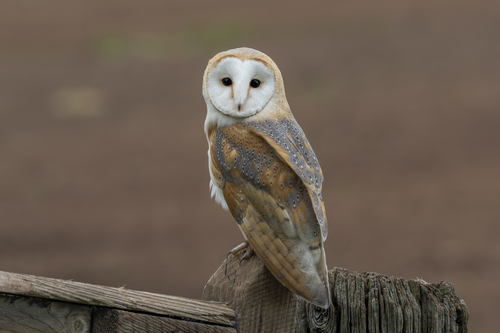
Barn Owl
The Barn Owl (Tyto alba) is one of the most widely distributed bird species, found on every continent except Antarctica. Recognizable by its heart-shaped face and ghostly white plumage, it plays a crucial role in controlling rodent populations, making it a valuable ally to farmers. Unlike many other owl species, the Barn Owl is generally not hooting; instead, it produces a range of screeches, hisses, and clicks. It has held various cultural significances, often associated with myths and folklore, sometimes seen as an omen of death or, conversely, a symbol of wisdom.
33-39 cm
Length
80-95 cm
Wingspan
Least Concern
Conservation Status
Distribution
Barn Owls are found worldwide, inhabiting North and South America, Europe, Africa, Asia, and Australia. They are absent only from Antarctica and some remote islands. Their range includes a variety of altitudes, from sea level to mountainous regions, though they generally avoid extremely cold or high-altitude environments. They are non-migratory in many regions, but some populations may undertake short-distance movements in response to food availability.
Lifespan
Typically 2-4 years in the wild, although some individuals can live much longer. Captive Barn Owls have been known to live over 20 years.
Barn Owl's Habitat
Habitat Types
Open woodlands, Grasslands, Agricultural fields, Marshes, Urban areas (often near parks or green spaces)
Climate Zones
Temperate, Tropical, Subtropical, Arid
Adaptations
Barn Owls have adapted to a wide range of habitats. Their exceptional hearing, facilitated by asymmetrically placed ears, allows them to locate prey in dense vegetation or under snow cover. They also have specialized feathers that enable silent flight, crucial for stealthy hunting.
Variations
Numerous subspecies of Barn Owls exist, differing in size, coloration, and habitat preferences. For example, some island subspecies are smaller than their mainland counterparts. These variations are often subtle and require expert analysis for identification.
Appearance
Breeding Plumage
Plumage remains relatively consistent throughout the year.
Seasonal Feather Changes
Minimal seasonal variation.
Sex Based Plumage Differences
Females tend to have more spotting on their underside than males.
Notable Features
Heart-shaped facial disc, White or light-colored underparts, Golden-buff upperparts with gray markings, Long legs and powerful talons, Dark eyes
Diet and Feeding
Primary Foods
Small rodents (voles, mice, rats), Shrews, Small birds, Insects (occasionally)
Foraging Behavior
Barn Owls primarily hunt at night, using their exceptional hearing to locate prey. They often fly low over open ground, listening for the rustling of rodents. They may also perch and wait for prey to appear.
Specializations
Asymmetrical ear openings allow for precise sound localization. Serrated edges on their primary feathers muffle the sound of their flight, enabling them to approach prey undetected.
Seasonal Diet Variations
Diet may shift slightly depending on prey availability. For example, during winter, when rodent populations may decline, they might consume more birds or insects.
Behavior
Social Structure
Barn Owls are generally solitary or live in pairs. They are not typically found in large flocks.
Communication
Screeches (used for territorial defense and courtship), Hisses (used as a warning or threat display), Clicks and snaps (produced with the beak), Chitters and twitters (used by chicks)
Migration
Most Barn Owl populations are non-migratory, but some may undertake short-distance movements in response to harsh weather or food shortages.
Territorial or Group Behaviors
Barn Owls are territorial, defending their nesting and hunting areas from other Barn Owls. They may engage in aerial chases and vocal disputes.
Conservation
Threats
Habitat loss (due to agricultural intensification and urbanization), Pesticide use (secondary poisoning from consuming poisoned rodents), Vehicle collisions, Loss of nesting sites (due to building renovations and removal of old trees)
Protection Programs
Provision of nest boxes, Habitat restoration and conservation, Promotion of rodent control methods that minimize pesticide use, Monitoring programs
Local National Laws
Barn Owls are protected under various national and international laws, including the Migratory Bird Treaty Act in the United States and the Wildlife and Countryside Act in the United Kingdom.
Population Trend
Stable
Population Estimates
The global population is estimated to be 4-10 million individuals, but accurate estimates are difficult to obtain.
Interesting Facts
Barn Owls can swallow their prey whole.
They later regurgitate indigestible parts, such as bones and fur, in the form of pellets.
Their heart-shaped face is not just for looks.
It acts as a sound funnel, directing sound waves to their ears and enhancing their hearing.
Barn Owls have excellent night vision.
Although, like all owls, their hearing is their primary sense for hunting in darkness.
They are sometimes called "Monkey-faced Owls".
This is due to their distinctive facial disc.
Faqs about Barn Owl
Are Barn Owls dangerous to humans?
No, Barn Owls are not dangerous to humans. They are shy and avoid human contact. They may defend their nest if threatened, but attacks are extremely rare.
What should I do if I find a Barn Owl chick?
If you find a healthy Barn Owl chick that has fallen from its nest, it is best to leave it alone. The parents are likely nearby and will continue to care for it. If the chick is injured, contact a local wildlife rehabilitator. *Consult a professional for medical or expert advice.*
Do Barn Owls hoot?
No, Barn Owls do not hoot. They make a variety of other sounds, including screeches, hisses, and clicks.
How can I attract Barn Owls to my property?
You can attract Barn Owls by providing suitable nesting sites, such as nest boxes, and maintaining open areas with plenty of prey (rodents). Avoid using rodenticides, as these can poison owls.
Copyright @ Nature Style Limited. All Rights Reserved.
 English
English